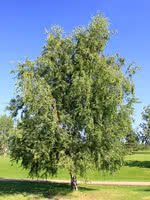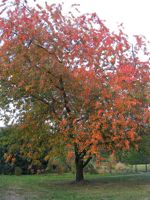Mon-Fri 9am - 5pm Mountain time
European White Birch vs Black Cherry
Betula pendula
Prunus serotina
NOT AVAILABLE THIS SEASON - MIGHT RETURN
NOT AVAILABLE THIS SEASON - MIGHT RETURN
European White Birch is a mid-sized shade tree native to Eurasia. This deciduous tree has a pyramidal form when young, maturing into a rounded crown with arched branches and drooping branchlets.
The trunk is slender, with white bark featuring black diamond-shaped lenticels. European White Birch is an ideal landscape tree for parks and gardens.
Similar to the Cutleaf Weeping Birch, this species is a popular ornamental.
Note: Unfortunately this difficult to grow species is not currently scheduled to grow at TreeTime.ca. Perhaps try purchasing seed from SeedTime.ca and growing your own? Or sign up for a restock notification above.
Black Cherry is common in eastern North America but a rare find elsewhere. This tree is shade tolerant and is often found in old fields, forest openings, and along fencerows.
The fruit is edible and is commonly used to flavor rum and brandy. It is also edible and often eaten fresh or used in wine or jelly. Black Cherry trees typically begin producing fruit when they are 10 years of age.
Black Cherry wood is a rich reddish-brown color and is strong, making it valued in cabinetry and woodworking. It is often used in reclamation as well.
The leaves can poison livestock as they contain cyanide derivatives and precursors. However, many have noted that deer still seem to browse their trees with impunity and birds and other animals eat the fruit when available.
European White Birch Quick Facts
Black Cherry Quick Facts
Toxicity: bark and wilted leaves toxic to livestock

